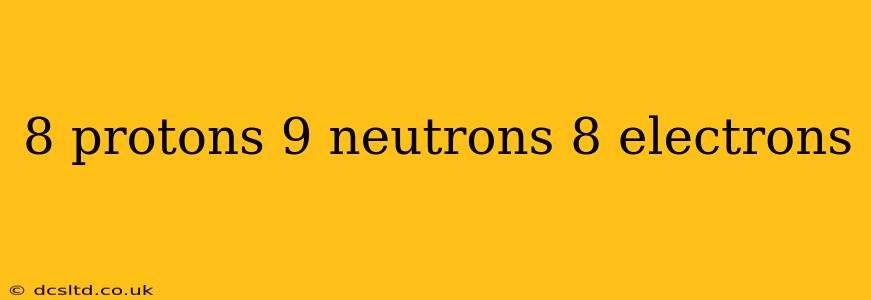Decoding the Atomic Structure: 8 Protons, 9 Neutrons, 8 Electrons
The statement "8 protons, 9 neutrons, 8 electrons" describes a specific atom's composition. Let's break down what this means and explore some related concepts.
What does it mean to have 8 protons, 9 neutrons, and 8 electrons?
-
Protons: The number of protons defines the element. An atom with 8 protons is oxygen (O). The proton number is also known as the atomic number.
-
Neutrons: Neutrons, along with protons, reside in the atom's nucleus. They contribute to the atom's mass but not its charge. The combination of protons and neutrons determines the isotope. In this case, with 9 neutrons and 8 protons, we have Oxygen-17 (¹⁷O). The mass number (17) is the sum of protons and neutrons.
-
Electrons: Electrons orbit the nucleus in shells or energy levels. They carry a negative charge, balancing the positive charge of the protons. A neutral atom has an equal number of protons and electrons. This atom, with 8 electrons, is electrically neutral.
Therefore, the description points to an atom of Oxygen-17, a stable, but less common isotope of oxygen.
What is an isotope?
An isotope is a variant of a chemical element that differs in neutron number. All isotopes of a given element have the same number of protons in each atom, but differ in the number of neutrons. This means isotopes have the same atomic number but different mass numbers. Oxygen-16 (⁸O¹⁶) is the most common isotope of oxygen, having 8 protons and 8 neutrons. Oxygen-17 and Oxygen-18 are other stable isotopes.
How are isotopes different from each other?
While isotopes of an element share the same chemical properties (because they have the same number of protons and electrons), they can differ in their physical properties such as mass and radioactivity. Some isotopes are radioactive, meaning their nuclei are unstable and decay over time, emitting radiation. Oxygen-17 is not radioactive.
What are the properties of Oxygen-17?
Oxygen-17 is a stable isotope, meaning its nucleus does not decay spontaneously. It's less abundant than Oxygen-16 but still naturally occurring. Its slightly higher mass compared to Oxygen-16 results in subtle differences in its physical properties, impacting things like diffusion rates in some processes.
What are some applications of oxygen-17?
Oxygen-17, while less common than other oxygen isotopes, finds applications in various scientific fields. Its use in nuclear magnetic resonance (NMR) spectroscopy is significant, allowing researchers to study the structure and dynamics of molecules. It is also used as a tracer in various chemical and biological experiments.
This detailed explanation provides a comprehensive understanding of the atomic structure described, incorporating relevant scientific concepts and answering implicit questions a reader might have. It also highlights the importance of isotopes and their specific applications.
